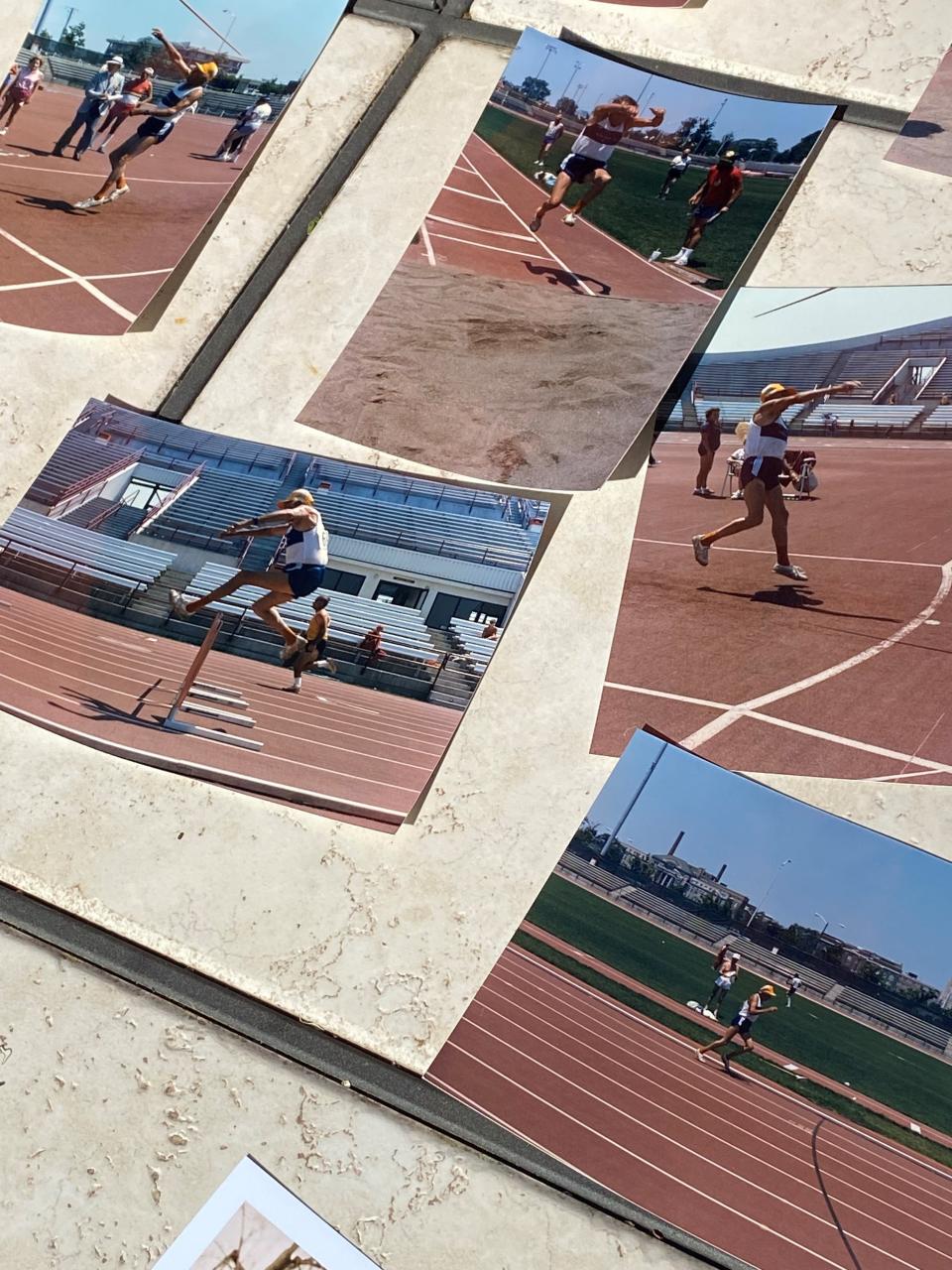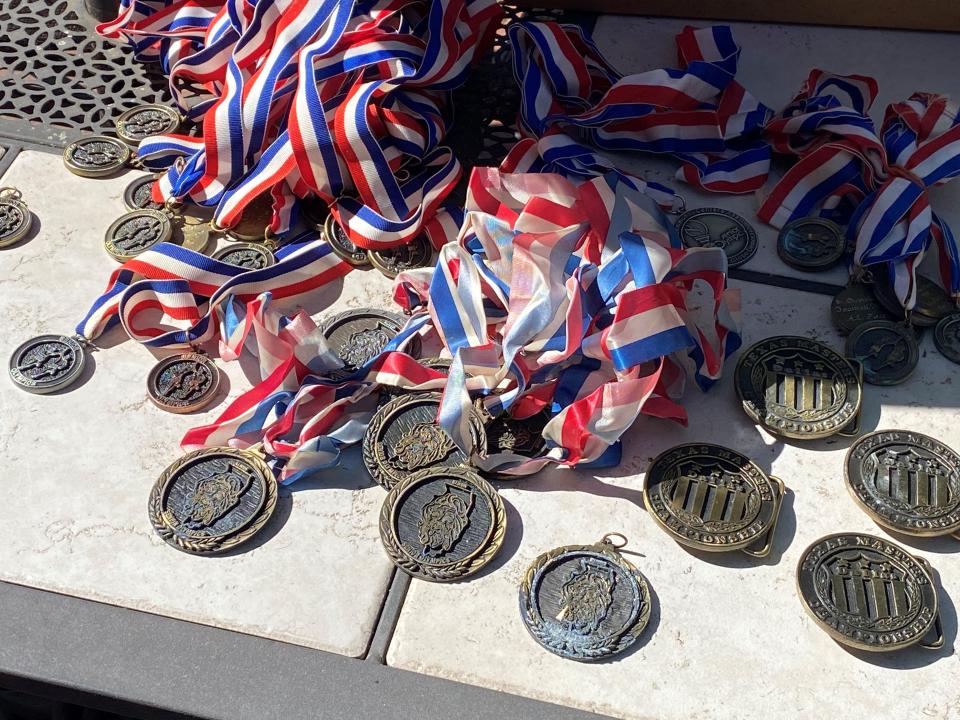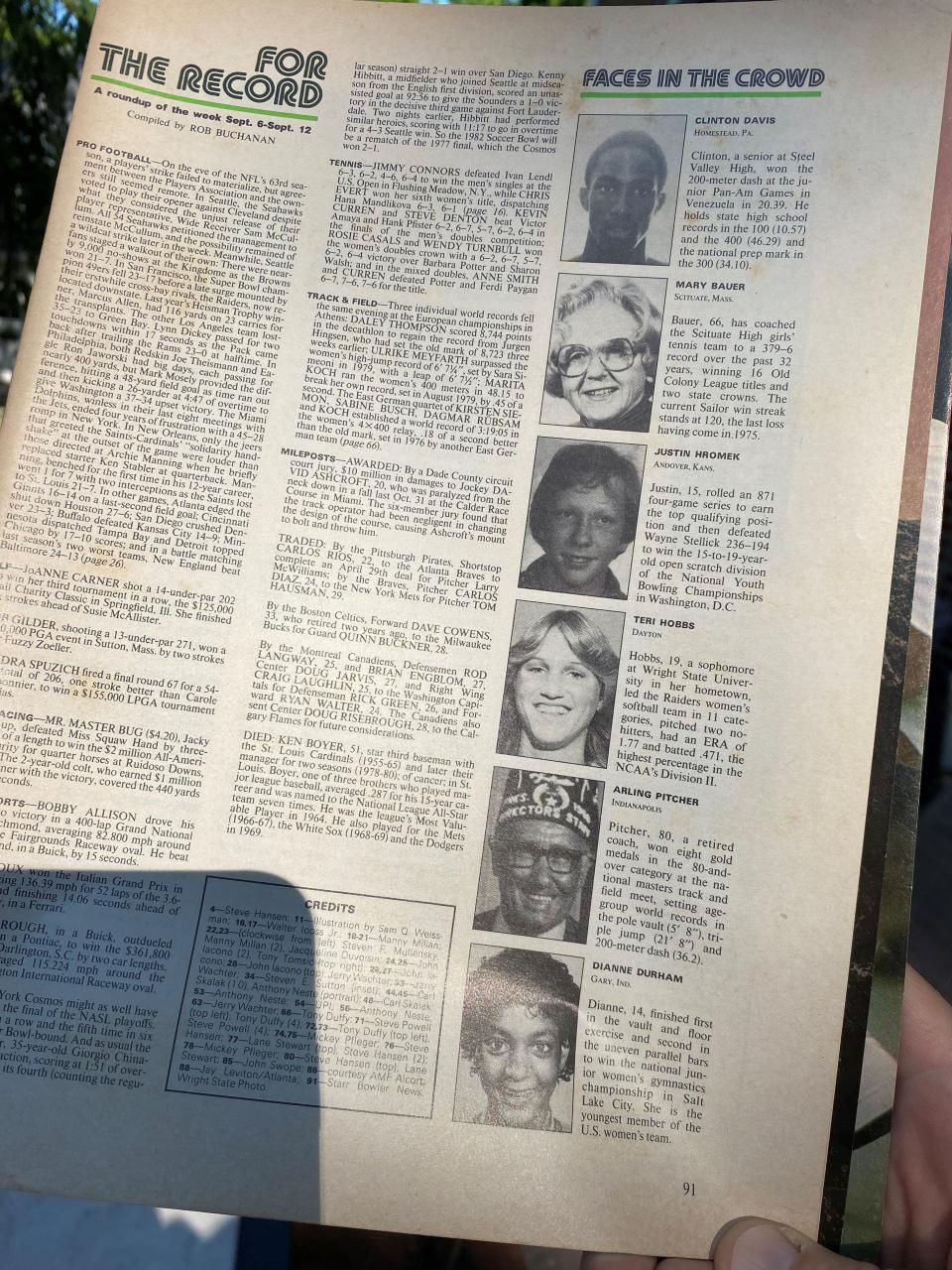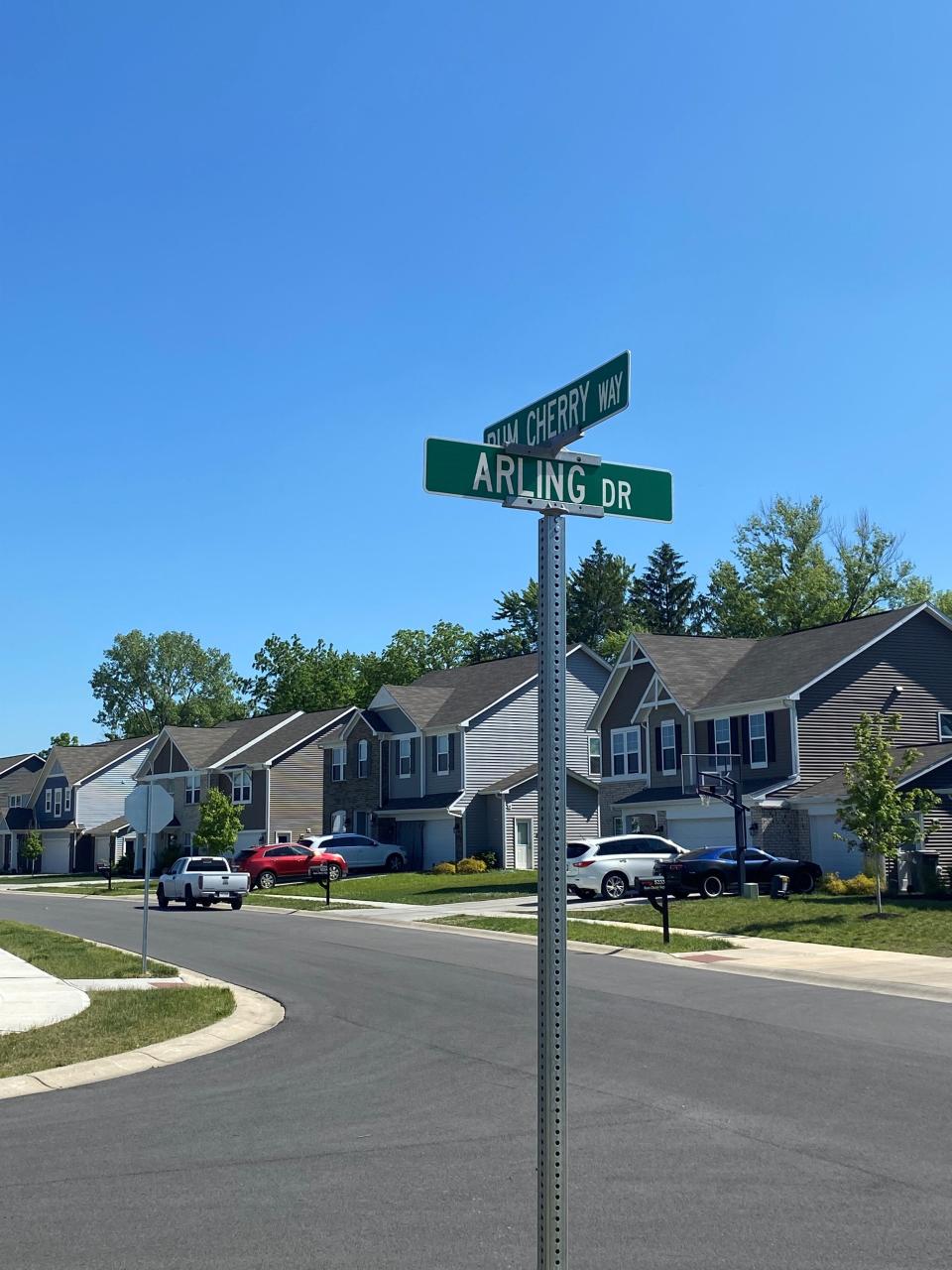Doyel: Arling Pitcher, legally blind, 90-year-old pole-vaulter, built Indy's Southside
INDIANAPOLIS – The medals are falling off the table, one after another, because there’s just no room for them all. It’s a big table on this beautiful lawn on the southside of Indianapolis, on a spot where hogs once roamed, but the table can’t hold the full story of the man who built this home, and some of the neighborhood around it.
You’re here to find out more about Arling Pitcher, but before you ask me a thing, let me ask you: How much time do you have?
Because this story, like the medals on the table, goes all over the place. It’s kind of like that El Camino back in the 1990s, with a teenage girl in the driver’s seat and the old man sitting next to her. That ugly old car went everywhere in those days, including Butler and UIndy, but the old man – her great-grandfather – preferred Roncalli, the school on the other side of those fields of wheat and corn and soy.
The old man didn’t build Roncalli. Not quite, anyway.
He was legally blind by then, pushing 90 years old but still competing in track, throwing javelins and high-jumping over bars held in place by cobs of corn – true story – but his favorite event was the pole vault. Yes, at age 90. Yes, legally blind.
You sure you have the time for this story?

Arling Pitcher, a Southport Hall of Famer
Before all of this – before he built that gas station, before he ran for state senate, before he set 25 world records in track – Arling Pitcher was a legend at Southport High. Good thing the man lived to be 94, right? Because otherwise there wasn’t enough time.
Pitcher didn’t just coach the football and wrestling teams at Southport. He started those programs from scratch, football in 1929 and wrestling in 1934. His football teams won so much, 12 county titles in all, that he struggled to schedule games.
“Speedway and Lawrence refused to play us,” he once told the IndyStar.
Pitcher didn’t just build a powerhouse at Southport’s stadium – he built the stadium. Well, he raised the money for it, $80,000 in all, back during The Depression when nobody had two nickels to rub together. This was 1934, and Pitcher applied for a Works Progress Administration grant and raised the rest of the money with bake sales, cake raffles and goat races. He supplied the goats.
An interesting man, Arling Pitcher.
But restless. In 1945 the war was ending and the world was changing and Pitcher decided to change with it, retiring at age 43 from coaching and teaching at Southport – U.S. history, economics, like that – to start a construction company.
A thrifty man with an uncanny business acumen, he’d purchased 60 acres of farmland in middle-of-nowhere, southern Marion County in 1944. Built a carriage house with his own two hands, then started working on another, and another, and pretty soon he’s built four houses and then the Lindbergh Highlands neighborhood, and now he’s building a mill on his property to manufacture school equipment to sell to the schools he was building.
A businessman, Arling Pitcher.
Thanks to progress, thanks to Arling Pitcher, the southside of Indianapolis was growing and there was talk of a major thoroughfare coming – Interstate Highway 65, the newspapers called it in 1957 – and Pitcher’s thinking ahead and building a gas station right where the road is coming, near the corner of Thompson Road and Carson Avenue. Eventually the station had to come down in the name of progress, but Pitcher made a pretty penny on the deal.
Back home on the family farm off Thompson Road, living in one of those houses Pitcher built about a half-mile east of the proposed interstate, Pitcher’s grandchildren tried in their own sweet way to slow down the project.
“My sister and I would take down the survey stakes,” says Marti Baker, a retired nurse-turned-attorney. “We didn’t want them to build the highway!”
Marti’s laughing about it now, on that beautiful lawn on the southside of Indianapolis, near the spot where hogs once roamed. We’re standing next to the table where the medals are falling, and I’m noticing something as Marti and her niece, Ruth Hurrle, gather the tokens from a world-class career in track: Almost every medal here is gold.
“How often did he not win?” I’m wondering aloud.
Marti’s shrugging. Ruth thinks about it for a bit, looks to Marti for confirmation and says, “There was that one guy from Italy.”

Much of Roncalli sports is on Pitcher's old land
Arling Pitcher won his first race in bare feet.
He was 77, with some friends from the Shriners to watch a track meet for masters runners – “old codgers,” Pitcher liked to call them – and his buddies were badgering Pitch to get out of the bleachers and onto the track. No, Pitch wasn’t going to do that. But then came an announcement over the P.A. system:
The 200-meter race was about to be canceled. A minimum of three entrants were required, and only two showed up.
Pitcher took off his dress shoes and socks, went down there cold and dusted those old codgers. Set a meet record and decided, hey, maybe this was something he should do more. Pretty soon he’s traveling the world and competing in sprints, jumps, throws and even the pole vault. He was setting age-group world records in all of them.
Name an event, and Pitch entered it. And he won. All those gold medals tell the story, and Ruth Hurrle is digging through them, looking for one from St. Louis or New Orleans, unless it’s from Australia or Puerto Rico or Rome. Who can remember? She turns over one medal to read the back.
“Senior Olympics, football throw!” Hurrle says, turning to her Aunt Marti and giggling.
A competitive bunch, the whole lot of ‘em. Pitcher's daughter, Georgia – that’s Marti’s mom – competed nationally in ballroom dancing. One of his granddaughters, Susan Oakley, took up tennis at age 45 and has won a handful of titles in the Carolinas. Grandson Dan Baker has run the Boston Marathon several times and recently won an age-group race in Florida. Two of Hurrle’s sisters won IHSAA softball titles at Roncalli and a brother won a football state title, as did her son, Joe, in 2020.
As for Ruth Hurrle, well, she graduated in 1992 as the first Roncalli girl athlete to letter four times in more than one sport. Roncalli didn’t have a girls swimming team in those days, so she swam with the boys – and won the city 100-meter butterfly.
Seven of Pitcher’s descendants have graduated from Roncalli, the school on the other side of all those hogs and wheat fields, a school he all but gave 14 acres in 1991. Money changed hands, but not much, and 32 years later folks at Roncalli remember it as more of a gift. The school’s practice fields for football and soccer sit on that land, as well as baseball and softball diamonds and the so-called bubble gym.
By 1991 Pitch had made his money. He was in a giving mood, and he wanted to give back to the place where his grandchildren went to school and where the track was always open to an old codger with a pole in the back of his El Camino.

Corn cobs and coat hangers
We’re looking through pictures now. Here’s Pitcher in a black beret, somewhere in Europe where a man can get away with such a thing, setting a world record in the hurdles. Here he is throwing the javelin. Here he goes into a pit of dirt. Long jump? Triple jump? Hard to say. He did both.
We’re at the table, digging through boxes that sit on top of the medals because there’s just not enough room, but all these scraps of paper keep getting in the way. They’re notes Pitcher kept on his track travels, naming the city and event and result. First place, usually. There’s also notes Pitcher’s wife, Lyda, used to leave for her husband, reminders of upcoming meets, written on a yellow legal pad in big, black 6-inch letters.
“Blind as a bat,” Ruth is saying of Pitcher, turning her head in that charming way of hers to giggle affectionately with Marti.
Ruth was the girl who drove Pitcher around town, anywhere he could find a pole vault pit. He learned the event in his late 70s, and soon became the world’s first octogenarian to clear 8 feet. People on the southside still talk about Pitcher and his El Camino, the pole sticking out the back.
“After a while you got used to it,” says Bob Tully, who’s retired now after decades as a Hall of Fame football coach and administrator at Roncalli. “There he is, pole vaulting again!”
Sometimes the El Camino would pull into the lot at Southport High, outside the stadium Pitcher built, and he’d head onto the track alone. By the time school let out and the Southport athletes joined him, Pitcher would’ve worked himself into a lather. They didn’t know who he was, not until Southport coach Scott Fangman told them later, but Rob Brown remembers the distance runners stretching as they watched the old man raise the bar to 8 or 9 feet and then walk down the runway with his pole.
“I still remember the first time I saw him go over the pole vault bar,” says Brown, a 1988 Southport graduate who coached cross country at Roncalli. “This mid-80s guy rambling down the runway, and we were all thinking, ‘No way.’ Then he cleared it no problem and we just fell out, yelling and carrying on like teenage boys do. Can close my eyes and see it. When it was warm, he worked out without a shirt. He didn’t have loose skin like older people do. It was tight, and he was the color of a catcher’s mitt.”
By his 90th birthday Pitcher was clearing lower and lower heights. He tended to be the only competitor in his age group, but nobody was going to give him a medal. He was there to earn it. Problem was, he could no longer clear the lowest setting on the pole vault or high jump, so he found a work around – wedging a corn cob into the lowest setting, dangling a wire clothes hanger from each cob, and setting the bar on the coat hangers.
“Those corn cobs are one of my favorite memories of Pitch,” Ruth Hurrle says and then starts digging through the boxes. She knows there’s a picture in here somewhere, but eventually gives up the hunt. There’s just too much.

Do Arling Drive residents know who "Arling" was?
For a man who built so many things – houses, schools, subdivisions, even an addition to the Murat downtown – Arling Pitcher doesn’t have his name on much.
There’s the tombstone at Greenwood Cemetery, a small piece of marble with his name, date of birth (Dec. 2, 1901) and death (May 6, 1996), and the square-and-compass symbol of a Freemason. But nothing at Roncalli. Nothing at Southport, other than the plaque in the atrium at Southport High, where he’s in the athletic hall of fame. Nothing in the Lindbergh Highlands neighborhood. Nothing even at the sprawling estate on Thompson Road, which he called The Farm.
“Well,” Ruth is saying, “I can think of something.”
Pitcher’s great-granddaughter is pointing to the Highgate Homes neighborhood on the other side of the carriage house. Pitcher didn’t build Highgate Homes, but it sits on some of the original 60 acres he purchased in 1944.
“The main road over there is named for him,” she says.
We’re about done here, and after we carry the boxes of medals, pictures and paper scraps into one of the homes on The Farm, after Ruth and Marti and I say our goodbyes, it’s time to leave. My route on Thompson Road takes me past Highgate Homes, so I turn left into the neighborhood and take Rum Cherry Way until I see it:
Arling Drive.
Now I’m hopping out and noticing the house on the corner. Cars in the driveway, so somebody’s home. Knock on the door. A woman answers, holding one cat as another slips past her feet, and I’m picking up the runaway kitty and introducing myself. It’s a little awkward, me holding her cat and trying to explain something as silly as this. I give it a try.
“I’m writing a story about the man whose name is on your street,” I’m telling the woman, whose name is Jen. “Know anything about Arling?”
No, she says. Sorry, she says.
Oh that’s OK, I’m telling her, just a shot in the dark. I turn to leave. Jen stops me with a question:
“Who was he?”
Maybe it’s because I’ve spent the last hour with Ruth, but now I’m the one turning my head and giggling. Then I tell this woman who lives on Arling Drive:
“How much time do you have?”
Find IndyStar columnist Gregg Doyel on Twitter at @GreggDoyelStar or at www.facebook.com/greggdoyelstar.
This article originally appeared on Indianapolis Star: Arling Pitcher pole vaulted at age 90 after building much of Southside

